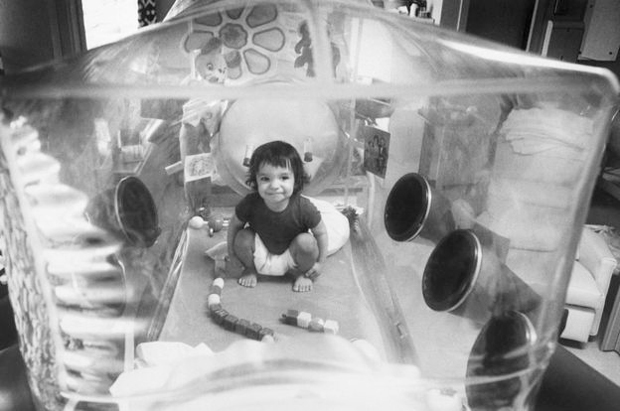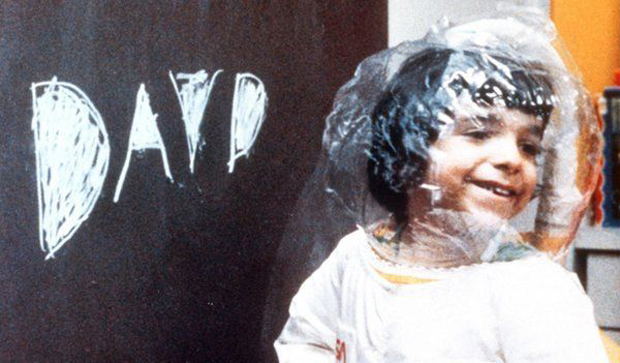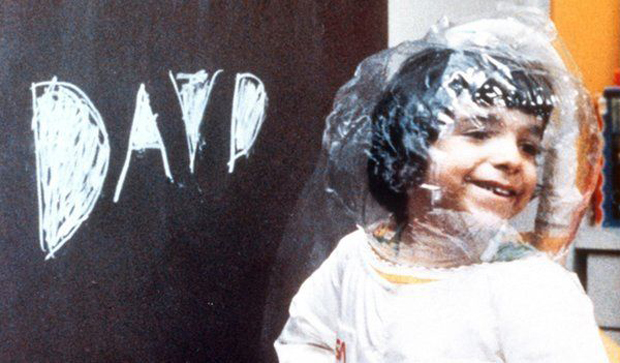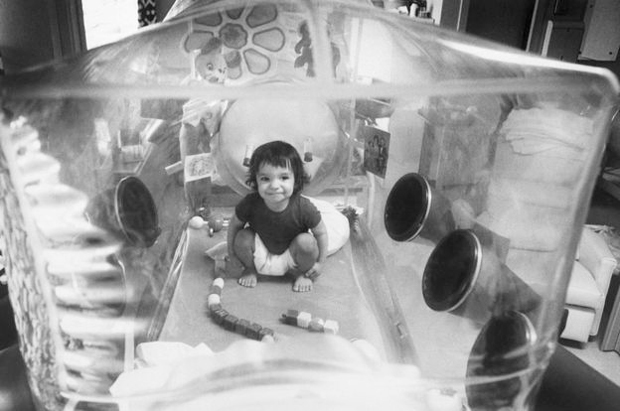
평생을 멸균풍선 속에서 살아야 해 ‘버블보이 병’(Bubble Boy Disease)으로 불리는 중증복합면역결핍질환 ‘스키드’(SCID, Severe combined immunodeficiency)에 걸려 12세의 나이로 사망한 데이비드 베터
에이즈에 따라붙는 불치병이란 수식어는 필연적으로 원인 바이러스인 HIV에 대한 부정적 인식으로 이어졌다. 그러나 최근 미국에서 이 HIV 바이러스를 이용해 또다른 불치병을 치료한 사례가 나왔다. 18일(현지시간) ‘뉴 잉글랜드 저널 오브 메디슨’은 에이즈 바이러스로 일명 ‘버블보이 병’을 치료했다는 논문을 실었다.
‘버블보이 병’(Bubble Boy Disease)으로 알려진 X-SCID는 중증복합면역결핍질환 ‘스키드’(SCID, Severe combined immunodeficiency) 중 가장 흔한 형태다. 돌연변이 유전자 때문에 선천적으로 면역 기능 없이 태어나는 유전병이다. 감기는 물론 모든 종류의 감염에 취약해 감염체들로부터 격리가 필요하다. 평생을 풍선 모양의 멸균실에서 살아야 하는 이유다. 신생아의 100만분의 3 정도에서 발견된다. 일반적인 치료 방법으로는 골수이식이 있지만 화학요법으로 인한 혈액 장애, 겸상적 세포 빈혈, 대사 증후군 등 다양한 부작용으로 지금까지 큰 성공을 거두지는 못했다.
처음 ‘버블보이’로 불린 건 1971년 미국 텍사스에서 태어난 데이비드 베터였다. 데이비드의 부모는 첫 아들을 생후 7개월 만에 스키드로 잃었다. 다음 임신에서 태아가 스키드에 걸릴 확률 역시 반반이었지만, 이들은 딸 캐서린과 데이비드를 연이어 출산했다. 다행히 캐서린은 아무 문제 없었는데 문제는 데이비드였다. 데이비드는 스키드 환자였고 텍사스 휴스턴 아동병원은 데이비드를 풍선 모양의 멸균실에 보호하며 연구를 진행했다. 1983년 의료진은 데이비드에게 캐서린의 골수를 이식했지만 사전 검사에서 놓친 캐서린의 골수 속 바이러스에 감염됐다. 죽음에 가까워진 데이비드는 결국 풍선 바깥으로 나왔고 보름만인 1984년 2월 22일 만 12세의 나이로 사망했다.

평생을 멸균풍선 속에서 살아야 해 ‘버블보이 병’(Bubble Boy Disease)으로 불리는 중증복합면역결핍질환 ‘스키드’(SCID, Severecombined immunodeficiency)에 걸려 12세의 나이로 사망한 데이비드 베터
이후 수많은 연구가 진행됐지만 2003년 임상실험에서도 11명의 스키드 어린이 환자 중 2명이 골수이식 부작용으로 사망하는 등 안전성이 보장되지 않았다. 그러나 미국 세인트 주드 어린이 병원 연구팀의 연구가 스키드를 앓고 있는 어린이들에게 새로운 희망으로 떠올랐다.
3년 전부터 시작한 연구에서 이들은 다름 아닌 HIV, 에이즈 바이러스를 통해 스키드 환자의 돌연변이 유전자를 교정했다. 이웰리나 맘카르즈 세인트주드어린이병원 소아혈관계학 및 종양학 박사는 “에이즈 유발 인자만을 제거한 변형 HIV를 사용해 스키드를 앓고 있는 8명이 6~24개월 안에 정상 수치의 면역세포를 갖게 됐다”고 밝혔다. 학계는 이 치료법이 다른 유전병 치료에도 활용도가 높을 것으로 기대하고 있다. 이번 연구의 공동저자로 지난해 11월 작고한 브라이언 소렌티노 박사는 생전 인터뷰에서 “버블보이병 치료에 처음으로 에이즈 바이러스인 HIV를 사용했다. 이는 높은 안전성을 가졌을 뿐 아니라 줄기세포를 교정하는데도 훨씬 효과적”이라고 밝힌 바 있다. 이로써 평생 세상 밖으로 나오지 못하고 멸균풍선 안에서 생활해야 하는 ‘버블보이 병’ 어린이 환자들에게 가족과 포옹을 나누고 하늘을 올려다볼 수 있는 길이 열리게 된 셈이다.
(원문: 여기를 클릭하세요~)
에이즈 바이러스로 ‘멸균실 생활 불치병’ 치료했다

평생을 멸균풍선 속에서 살아야 해 ‘버블보이 병’(Bubble Boy Disease)으로 불리는 중증복합면역결핍질환 ‘스키드’(SCID, Severecombined immunodeficiency)에 걸려 12세의 나이로 사망한 데이비드 베터
에이즈에 따라붙는 불치병이란 수식어는 필연적으로 원인 바이러스인 HIV에 대한 부정적 인식으로 이어졌다. 그러나 최근 미국에서 이 HIV 바이러스를 이용해 또다른 불치병을 치료한 사례가 나왔다. 18일(현지시간) ‘뉴 잉글랜드 저널 오브 메디슨’은 에이즈 바이러스로 일명 ‘버블보이 병’을 치료했다는 논문을 실었다.
‘버블보이 병’(Bubble Boy Disease)으로 알려진 X-SCID는 중증복합면역결핍질환 ‘스키드’(SCID, Severe combined immunodeficiency) 중 가장 흔한 형태다. 돌연변이 유전자 때문에 선천적으로 면역 기능 없이 태어나는 유전병이다. 감기는 물론 모든 종류의 감염에 취약해 감염체들로부터 격리가 필요하다. 평생을 풍선 모양의 멸균실에서 살아야 하는 이유다. 신생아의 100만분의 3 정도에서 발견된다. 일반적인 치료 방법으로는 골수이식이 있지만 화학요법으로 인한 혈액 장애, 겸상적 세포 빈혈, 대사 증후군 등 다양한 부작용으로 지금까지 큰 성공을 거두지는 못했다.
처음 ‘버블보이’로 불린 건 1971년 미국 텍사스에서 태어난 데이비드 베터였다. 데이비드의 부모는 첫 아들을 생후 7개월 만에 스키드로 잃었다. 다음 임신에서 태아가 스키드에 걸릴 확률 역시 반반이었지만, 이들은 딸 캐서린과 데이비드를 연이어 출산했다. 다행히 캐서린은 아무 문제 없었는데 문제는 데이비드였다. 데이비드는 스키드 환자였고 텍사스 휴스턴 아동병원은 데이비드를 풍선 모양의 멸균실에 보호하며 연구를 진행했다. 1983년 의료진은 데이비드에게 캐서린의 골수를 이식했지만 사전 검사에서 놓친 캐서린의 골수 속 바이러스에 감염됐다. 죽음에 가까워진 데이비드는 결국 풍선 바깥으로 나왔고 보름만인 1984년 2월 22일 만 12세의 나이로 사망했다.

평생을 멸균풍선 속에서 살아야 해 ‘버블보이 병’(Bubble Boy Disease)으로 불리는 중증복합면역결핍질환 ‘스키드’(SCID, Severecombined immunodeficiency)에 걸려 12세의 나이로 사망한 데이비드 베터
이후 수많은 연구가 진행됐지만 2003년 임상실험에서도 11명의 스키드 어린이 환자 중 2명이 골수이식 부작용으로 사망하는 등 안전성이 보장되지 않았다. 그러나 미국 세인트 주드 어린이 병원 연구팀의 연구가 스키드를 앓고 있는 어린이들에게 새로운 희망으로 떠올랐다.
3년 전부터 시작한 연구에서 이들은 다름 아닌 HIV, 에이즈 바이러스를 통해 스키드 환자의 돌연변이 유전자를 교정했다. 이웰리나 맘카르즈 세인트주드어린이병원 소아혈관계학 및 종양학 박사는 “에이즈 유발 인자만을 제거한 변형 HIV를 사용해 스키드를 앓고 있는 8명이 6~24개월 안에 정상 수치의 면역세포를 갖게 됐다”고 밝혔다. 학계는 이 치료법이 다른 유전병 치료에도 활용도가 높을 것으로 기대하고 있다. 이번 연구의 공동저자로 지난해 11월 작고한 브라이언 소렌티노 박사는 생전 인터뷰에서 “버블보이병 치료에 처음으로 에이즈 바이러스인 HIV를 사용했다. 이는 높은 안전성을 가졌을 뿐 아니라 줄기세포를 교정하는데도 훨씬 효과적”이라고 밝힌 바 있다. 이로써 평생 세상 밖으로 나오지 못하고 멸균풍선 안에서 생활해야 하는 ‘버블보이 병’ 어린이 환자들에게 가족과 포옹을 나누고 하늘을 올려다볼 수 있는 길이 열리게 된 셈이다.
(원문: 여기를 클릭하세요~)
Treatment restores immune-system function in young children with severe disorder.
A five-month-old boy with severe combined immunodeficiency disease receives care at a California hospital in 2017.Credit: Santiago Mejia/Polaris/eyevine
An experimental gene therapy has restored functioning immune systems to seven young children with a severe disorder that would have sentenced them to a life of isolation to avoid potentially deadly infections. They are now with family at home, and an eighth child is slated to be released from hospital at the end of this week.
The children have mutations in a gene that is crucial for immune-system development, causing a disorder called X-linked severe combined immunodeficiency (SCID-X1). The gene-therapy treatment replaces the mutated gene, called IL2RG, with a corrected copy. SCID-X1 and related disorders are sometimes called ‘bubble-boy’ diseases because of the plastic enclosures that were once used to protect affected children from possible infection. For them, even a common cold can be fatal.
But seven of the babies in the study1, which was published on 17 April in The New England Journal of Medicine, now have immune systems that can protect them against common childhood aliments. “They are all toddlers now, exploring life and attending day cares,” says Ewelina Mamcarz, a physician at St. Jude Children’s Research Hospital in Memphis, Tennessee, and a lead author on the study.
The best treatment currently available for SCID-X1, which predominantly affects boys, is a bone-marrow transplant from a matched sibling donor. But that option is possible for less than 20% of children with the disorder. Researchers have been trying for nearly 20 years to develop a way of delivering a functional copy of the mutated gene to affected children who can’t receive such a transplant.
Those efforts met with mixed results2: the earliest trials partially improved immune responses, but caused leukaemia in some patients. In a follow-up effort3 in 2014, the same researchers altered a virus they had been using to shuttle functional copies of the IL2RG gene into cells. It still produced only partial improvement in immunity, but none of the children who were treated developed leukaemia.
An enduring cure?
For the latest trial, Mamcarz and her colleagues used yet another virus, this time a disabled relative of HIV. This virus is more adept than the ones researchers had previously used at inserting genes into cells that are not actively dividing — making it better suited for use in the slowly dividing stem cells responsible for generating immune cells.
The team also treated the children with a low dose of chemotherapy before the treatment. That approach is also used in another gene therapy for a related disease called ADA-SCID. That therapy was approved by the European Medicines Agency in 2016.
The children treated for SCID-X1 have shown no signs of leukaemia up to two years after their treatment. Although some cases of leukaemia showed up after two years in previous studies, Fischer says that researchers have been using this viral system for other gene-therapy trials for a decade without any signs of leukaemia.
And the children in the SCID-X1 trial are producing the proper components of a healthy immune system, including T cells, B cells and natural-killer cells. “This is a very nice contribution to the field,” says Alain Fischer at the College of France in Paris, who developed some of the first experimental gene therapies used to treat SCID-X1.
The results are promising, but researchers will need to continue monitoring the children to ensure that the immune capabilities they developed after treatment remain stable, says Marina Cavazzana, who is also working on gene therapies for SCID-X1 at Necker Hospital for Sick Children in Paris.
“From a physiological point of view and from a quality-of-life point of view, this is a cure,” says James Downing, president of St. Jude Children’s. “Will it be a durable cure? Only time will tell.”
(원문: 여기를 클릭하세요~)
